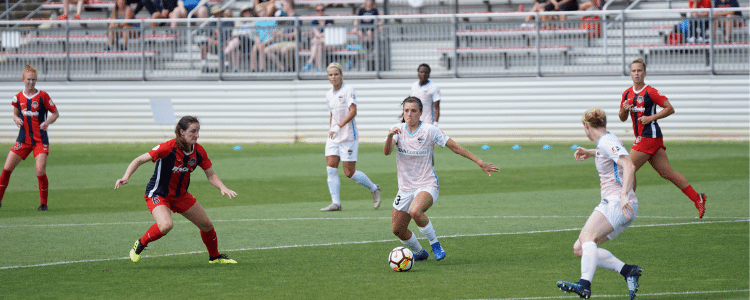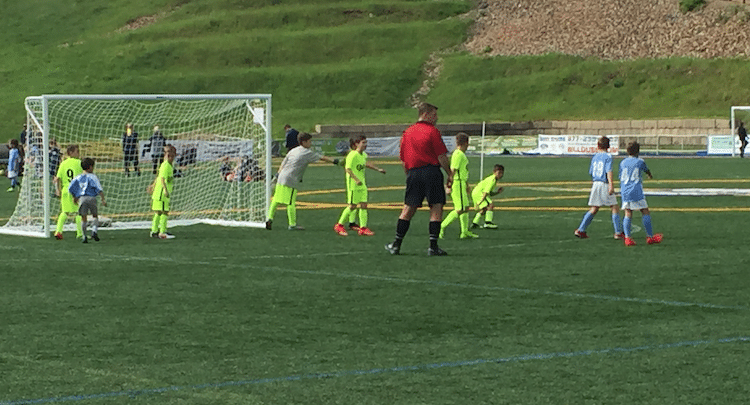What is an Assist in Soccer?

What is an assist in soccer? An assist is a pass that leads directly to a goal.
It’s an important soccer statistic that helps measure a player’s contribution to their team’s success.
Assists can come in many forms, including through passes, crosses, and even rebounds. The key factor is that the pass must have a direct impact on the goal being scored.
Key Takeaways From This Article:
- An assist in soccer leads to a goal.
- A second assist is a pass that leads to the assist of a goal. For example, player A passes it to player B who passes it to player C who scores. Player A gets credited with the second assist. Player B gets the assist.
- In many cases, getting assists shows that a player is an impactful player even if they don’t score many goals.
If a player passes the ball to another player who then dribbles past several defenders before scoring, the original passer will not receive an assist.

However, if the pass leads directly to the goal, even if it’s deflected or redirected by another player, the passer will receive an assist.
Let’s explain what an assist in soccer is a little further…
Assists Should Get Love Too
As I mentioned above, assists are the passes that lead to a goal. The pass can be intentional or unintentional, and it can be made with any part of the body except for the hands or arms. The final pass before the goal is scored is the one that counts as an assist.
They can be a reflection of the impact of a player.
In this section, we will go over the types of assists and the rules for awarding assists.
Types of Soccer Assists
There are several types of assists in soccer.
The most common type is the through ball, which is a pass that goes between two defenders and sets up a one-on-one situation for the attacking player.
Another type of assist is the cross, which is a pass from the side of the field that goes into the box and sets up a scoring opportunity.
A corner kick can also result in an assist if the ball is headed into the goal by a teammate.
Rules for Assists in Soccer
The rules for awarding assists can vary depending on the league and the competition.
In general, an assist is awarded to the player who makes the final pass before the goal is scored. The pass must be deemed to have contributed directly to the goal.
If the pass is deflected by an opposing player before it reaches the scorer, it may not be counted as an assist. This is a very grey area.
It is also important to note that some leagues have stricter rules for awarding assists. For example, in the English Premier League, their definition of an assist is as follows…
An assist can be awarded for a pass or cross, even if an opponent gets a touch before the goal is scored. However, that touch must not significantly alter the intended destination of the ball.
That “intended destination” can often be a team-mate if he is a clear target. But it may also be an area of the pitch.
This is often the case with headed passes, long punts or clearances and crosses from set-pieces.
Understanding the basic definition of assists, the types of assists, and the rules for awarding assists can help you appreciate this aspect of the game even more.
What is Second Assists in Soccer?

A second assist is a pass that leads to the assist. In other words, it’s the pass that sets up the pass that leads to the goal.
For example, if you pass the ball to your teammate, and your teammate then passes the ball to another player who then scores a goal, then it means that you have made a second assist or a secondary assist.
While not all professional leagues and competitions officially recognize second assists, they are still important in analyzing a team’s performance. Second assists are a measure of a player’s ability to create scoring opportunities for their teammates and contribute to the build-up play.
In youth soccer, as far as I know, second assists aren’t tracked. In fact, most leagues do not track assists. Leagues will keep tabs on individual goals only but coaches should respect and understand that it is an important factor to an offense.
Soccer Assist Statistics
Assists can provide valuable insights into a player’s performance. Here are some key points to keep in mind when analyzing assist statistics:
Importance of Assists in Soccer Statistics

Assists are often used as a measure of a player’s creativity and ability to create scoring opportunities for their team.
A high number of assists can indicate that a player is an effective playmaker, and is able to read the game well and make accurate passes.
Assists can also be a useful metric for evaluating the effectiveness of a team’s attacking play. By tracking the number of assists that a team generates, coaches can gain a better understanding of the team’s overall attacking strategy and identify areas for improvement.
Limitations of Assist Statistics
While assists can be a useful metric for evaluating a player’s performance, they do have some limitations. For example:
- Assists do not account for missed chances: A player may make a great pass that sets up a scoring opportunity, but if the teammate fails to convert the chance, no assist is recorded. Teams with elite strikers will typically fill up the stat line and there’s an assist to be awarded to support their goal.
- Assists do not account for individual effort: A player may create a scoring opportunity through individual skill and effort, but if no pass is made, no assist is recorded.
- Assists do not account for defensive contributions: A player may make a key defensive play that leads to a counter-attack and eventual goal, but if no pass is made, no assist is recorded.
I guess what I’m trying to say is that an assist is just a small part of the game. There are many intangible factors that can be a good reflection of how effective a player is. These intangibles aren’t tracked on a score sheet but parents and fans will take notice.
Assist Strategies in Soccer

Team Strategies for Creating Assists
To create more opportunities for assists, your team needs to work together. Here are some team strategies you can use:
- Play with width: By spreading out the field, you can create more space for your teammates to move into. This makes it easier to pass the ball and create scoring chances.
- Make runs: By making runs into space, you can create opportunities for your teammates to pass you the ball. This can lead to more assists and more goals.
- Use set pieces: Set pieces like corners and free kicks can be great opportunities to create scoring chances. Work with your team to come up with set piece routines that can lead to assists and goals.
Individual Strategies for Creating Assists
As an individual player, there are also things you can do to create more assists. Here are some individual strategies you can use:
- Look for passes: Always be looking for opportunities to pass the ball to your teammates. Even if you don’t score, you can still contribute to the team by creating scoring chances.
- Be creative: Don’t be afraid to try new things. Sometimes the best assists come from unexpected passes or moves.
- Develop your technique: The better your passing and dribbling skills, the more opportunities you will have to create assists. Practice your technique regularly to improve your skills. Repetition is your friend. Use a rebounder to get in 100 touches every day. This will help you get better touches on the ball to help improve your passing.
By using these assist strategies, you can become a valuable member of your team and help lead them to victory.
Final Thoughts on Assists
I hope that helps you understand what an assist is in soccer! The definition is simple but the execution can be challenging.
There’s really nothing like a quality assist that a teammate just pokes into the goal.
As players get older, passing becomes more important. Kids start to level out in maturity and it becomes more difficult to take defenders on one-on-one. For this reason, creating scoring opportunities off smart, patient plays becomes effective in youth soccer.
Players who can set other players up for more scoring opportunities will always have a place on a team. Every youth soccer team needs a playmaker who can distribute the ball effectively.
I’ve witnessed strikers go from good to great because they are surrounded by better passers.
Frequently Asked Questions
What is an assist in soccer?
An assist in soccer is a statistic credited to a player who helps set up a goal scored by another player.
What qualifies as an assist?
An assist can be awarded to a player who passes the ball to the scorer, creates a chance with a dribble or a cross, or wins a free kick or a corner kick that leads to the goal. The pass must be intentional, in the same phase of the play, and made to a teammate.
Is it an assist if the player takes a touch?
Yes, it is possible for a player to be credited with an assist even if they take a touch before the scorer scores the goal. As long as the touch is significant and played a direct role in setting up the goal, it can be considered an assist.

Written By: Beau Bridges
Beau is the founder of SoccerNovo, dedicated to helping players and parents navigate the youth soccer landscape. As a former youth coach and soccer parent, he shares insights on player development, recruiting, and the ever-evolving soccer scene in the U.S.
Let’s connect





